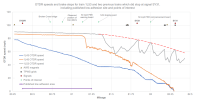I agree about the 90mph in the dark being normal, but scouring the line at 90 mph in the dark for a fallen tree whilst running on restrictive aspects is a few steps beyond normal.
Maybe, but for a seasoned Driver this may be 'normal' I'm 20yrs in and whilst defensive in style, I still remember times where you brake when you see the whites of their eyes. I know, from experience, you can hit one of our platforms at 60mph and still stop on the platform with room to spare. Would I do this in normal running ? Absolute no, but I know there is capacity to do so. One of my personal brake points is when I see a shadow, because the outline of the bank makes a perfect dark triangle against the hills in the distance. I know a few of my routes so intimately that I can judge almost precisely where little dips in the track are and where, in the dark, specific trees and lineside features are. Granted, I tend to choose big giant features that are blindly obvious or lit up at night but you really can know a route inside and out. Especially after 20yrs driving it. Ever counted AWS magnets in the fog ?
Even as a Driver I find it difficult to criticise. Firstly, we are looking at this in hindsight, knowing what all the variables were. If the Driver managed to stop just shy of the unit in front we would be hailing him a hero. Sully landed a plane on the Hudson but even in the aftermath he was heavily criticised. Hindsight is a wonderful thing. Even with all my experience, I still couldn't tell you what was right or wrong in the situation. I do not sign the route or the traction so I could only really go 'by the book' Which is what the RAIB tend to stick to.
When I was driving for two TOCs at the same time (don't ask..) There was a conflict of braking policies. However, I remember driving their route with one of their Instructors and he was really taken aback with my braking style. His comment was us on our best 'leaf-fall day' was still better than their worst. They would still leave it late because they knew it would still stop. When we got our new units the braking got a lot "worse" their performance in the slip is pretty phenomenal so your confidence level skyrocketed. I could even tell you about my TOCs brake policy once was to deliberately force the slide using heavier braking purely because it kicked in the auto sander as it doesn't apply in brake 1. There are just so many variables to consider.
I highlighted 'personally' because its exactly that. Other than following the company braking policy, it all comes down to how we individually handle our units. Would I brake later, knowing that I could brake and not get WSP and avoid a slide or brake earlier but know that I might be braking in the low adhesion zone ? I understand why someone might want to coast past it for a few seconds and then brake a little harder but avoid WSP activating.
Sometimes, the train just ain't gonna stop...
Station overrun incident at Stonegate, East Sussex, 8 November 2010.

www.gov.uk


